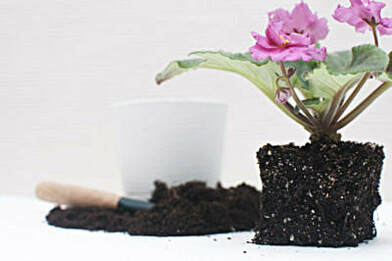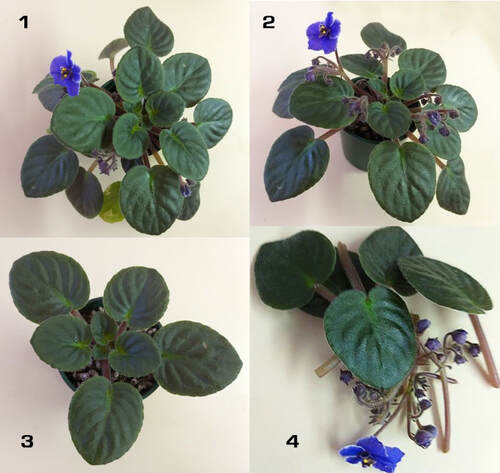
Grooming – Ruth Coulson (Ruth is with the Australian African Violet Association and lives on the Central North Coast of NSW) (Originally published on the African Violets Down Under Facebook page.(www.facebook.com/groups/241227626277942/?fref=nf) If you shouldn’t repot African violets in cold weather, what can you do? Why groom them, of course! Growth is much slower in cool conditions and the flowers are less prolific. But the upside is that the flowers are often larger, richer in colouring and last longer. But they do eventually die and will need to be removed. Outer leaves will deteriorate and need to be removed. And, naturally those pesky suckers will appear and need removal. There is plenty to do. But what can you do to improve a plant that is well overdue for repotting without actually repotting it? Photograph 1 is such a plant. It is Frosted Denim, a very lovely miniature. It has leaves out of place and growing in a curve, the plant itself is an odd shape, there is a sucker and many marked leaves. A bit of a mess, but trying to flower anyway. Photograph 2 was taken after I had groomed it. What I did was remove outside leaves until the worst of the marked and deteriorated ones were gone. I lifted the multitude of flower buds above the leaves so they could be seen. There was a very small “neck” on the plant, so I added a small amount of potting mix under the leaves. This sort of thing can be done at any time of the year and the impact on the plant is only minor, although it does look much better, even though it is a bit open in growth. Photograph 3 shows a further step that can be taken if you want to produce a high quality plant. I removed a further six leaves so that only one remains with marks on it. Those leaves were supporting the axils from which the flowers and buds were growing so I removed those as well. When I had done that it had a neck around 7 or 8 mm. It was impossible to cover that much by just adding potting mix, so I did a procedure that some of us call “lowering in the pot”. I slipped it out of the pot, sliced a careful 8mm off the bottom of the root ball and slipped it back in the same pot, adding mix at the top so the lowest leaves are once more at the level of the top of the potting mix. Photograph 4 shows the leaves and flower buds I removed. No problem though. It won’t take long to grow a bit and produce more flowers. And on a much lovelier plant this time! CAUTION: don’t undertake anything like “lowering in the pot” if you don’t have pretty warm conditions. Even in my plant room which never gets really cold I will keep it under a clear cover for a few weeks to grow a few new roots. |
